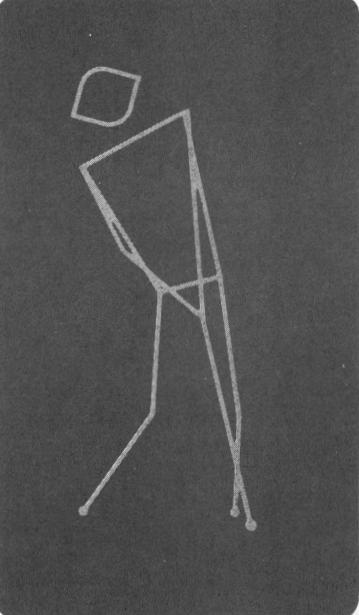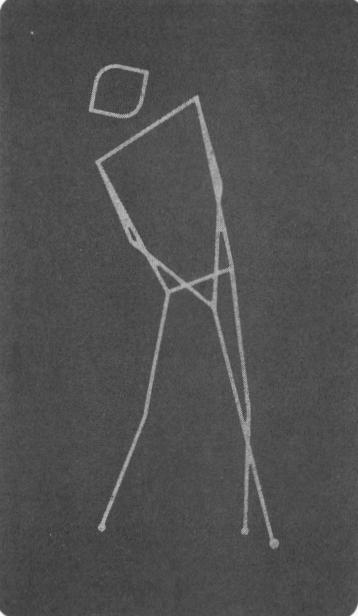| Previous | Index |
![]()
"The legs are important as stabilizers. Try shooting a cannon from a canoe, and you will appreciate the contribution of stabilizers."
pared to the passive movement of Ford's figure. Note also in the Nicklaus figure, that the left arm is perfectly straight whereas in Ford's it has begun to bow outward.
of improvement. The way to measure this is to track the center of gravity (c.g.). President Ford shifts his c.g. from a position 30 centimeters (cms) behind his left foot to 19 cms behind it, a displacement of I I cms Nicklaus' e.g. moves only three cms, the difference indicating Nicklaus uses a more rotary than linear shifting of his body.
"Now a rotary movement also minimizes the vertical shifting of the e.g. Ford's swing changed the height of his c.g. (raised it), while Nicklaus' remained nearly constant. Ford's pattern is inefficient. It can cause the player to top the ball or hit it after the club has passed perpendicular.
"Apparently, golfers require minimum leg movement. But this should not be interpreted to mean the legs are unnecessary. When you fire a cannon from a solid position on the ground, the ground does not move. This does no* :.can the ground does not contribute to the shot. Shoot a cannon from a canoe and you will appreciate the contribution of the ground."
Ariel acknowledges that if a person has inherently greater strength than another in certain body segments, that is the rub of the green; an advantage, providing the stronger one uses his gift. Jack Nicklaus does use his heavy, strong legs to good advantage. Other lesser endowed golfers find ways to compensate. Sheer strength is not the be-all, end-all, as Ariel appraised the fact that Ben Hogan won almost all his major championships after his nearly fatal auto-bus collision, which, among other things, seriously damaged his legs. Ariel believes the injury may have made Hogan's legs less active in his swing, which enabled him to better retain his center of gravity. More stable below, Hogan thus used his upper body more efficiently.
Have Gideon Ariel and his computer readouts revealed anything serious golfers and golf teachers have not already discovered over the many years of cogitation and experimentation? Perhaps not. In his notions of stopping the body at impact, rotating the hips, letting the clubhead work like a whip, for example, echo familiar ideas couched in different terminology, i.e., "hit against the left side,"
"turn," "swing the clubhead."
Ariel does not claim he is golf's latest Magellan charting new passages to the game's secret treasures. He justifies his work with a fair-sounding argument. To wit, although much of what has been learned up to now about golf technique has been on the mark, it has resulted essentially from guesswork.
"The human eye cannot quantify human movement," says Ariel. "The important things-timing, relative speeds of dozens of limbs and body segments, changes in centers of gravity-must be measured, weighed and compared to he of value. The best coaches cannot see these things with their own two eyes. Even exterior movements, which they can see, are hard to follow. They happen too fast. How can anyone see the position of the clubface at impact when the ball is on the clubface less than one millisecond, .8, to be exact`? A coach or player may guess right, but, if not, much time is lost, maybe a career, from taking the wrong tack."
It must be admitted that although Ariel had never before studied the golf swing, with or without computers, in a couple of days he had arrived at certain widely accepted elements of technique that have taken hundreds of golf teachers/students a few decades to reach. He feels sure that while he has never played golf (enthused by his analysis of Nicklaus-Ford, however, he is anxious to get into it) he will become a better player faster than another beginner without his knowledge.
"For one thing," says Ariel, "I wouldn't give much attention to minwte details like where my thumb is on the handle. They are not so important."
Quantification is what Gideon Ariel is up to. It may not be the final solution to the eternal puzzle that is golf, but it fills a few gaps. The Tour pros have been going in this direction on their own in stepping off yardages and speaking of having 171 yards to the pin. Such precise accounting seems silly at first glance. What is the difference between 171 and 173 yards on the swing to be made'? Maybe more than the old "feel it in the hands" crowd is willing to admit. 0
GOLF October 1978


![]()
| Previous | Index |